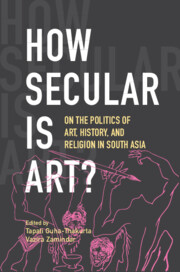3 - Art and the Secular in Contemporary India: A Question of Method
Published online by Cambridge University Press: 21 February 2023
Summary
Secular behaviours, secular habits of mind, secular institutions, and so on, once described with that adjective, are understood to illustrate of a conceptual domain that is, at the very least, divorced from the realm of the sacred. When compared with its supposed opposite, the secular is a relatively imprecise conceptual domain, with a loose set of phenomena forming its boundaries. It is best understood as realm of practice, made up of forms of self-fashioning or of meaning-making that are common or shared across religious communities and/or relatively independent of religion. Secular practices not only have precise and detailed genealogies but also robust lives in the present. They are intelligible and significant: when one acts in a secular way, that action is understood as such.
Historically, art—both in and outside of India—was transformed into a secular practice, when and as ideas of creation became anthropocentric. A feature of colonial modernity, art emerged as a secular site that is thick (like culture) rather than thin, active (like discourse) rather than passive. The secularity of art’s practices is grounded in its peculiar understanding of subjectivity: an idea of artistic expression in which the interiority of the self is both reflected and produced within an art object that is then interpreted by viewers long after the moment it is made. At the same time, art’s meanings are never just individual, and they often strike allegiances with more general cultural forms, including religion and myth.
In his anthropology of secularism, Talal Asad explores how Adonis, the Arabic poet, at once claims secular habits of mind as crucial to his practice and contemplates within his poetry a category of myth that emerges as the ‘plural, even anarchic’, mark of ‘unconscious truth’. This balance of secular and sacred is common among modern visual artists as well, whose habits of mind and bodily art practices are determinedly worldly, valuing the act of making as the most important part of being an artist. With very few exceptions, when forms of the sacred enter into art, they do so as source material, free for the artist’s taking.
- Type
- Chapter
- Information
- How Secular Is Art?On the Politics of Art, History and Religion in South Asia, pp. 63 - 90Publisher: Cambridge University PressPrint publication year: 2024



